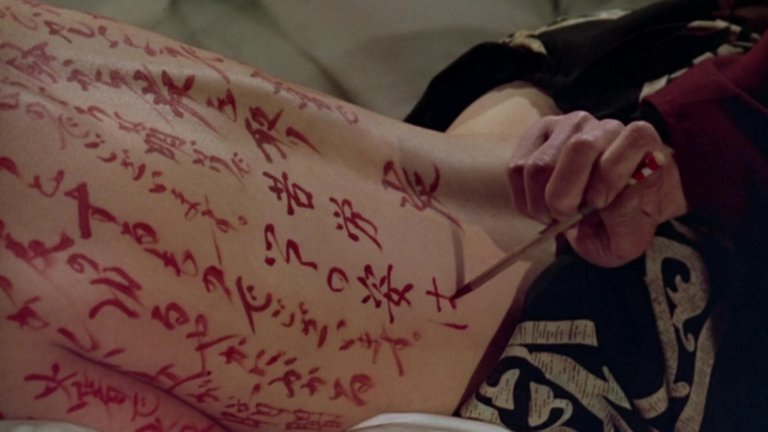
In old times "art film" was euphemism for porn. In our, seemingly more enlightened, times people could very well re-embrace that euphemism if their perception of "art" in films was based on the works of Peter Greenaway. Style and themes of his films are embodiment of everything people usually associate with the word "art", but Greenaway's films are usually remembered for nudity - quantities of which an average viewer could find only in porn films. That doesn't mean that Greenaway's films are particularly erotic, since nudity often comes together with images that are more likely to cause revulsion than sexual excitement. The closest thing to eroticism in Greenaway's work could be found in his 1996 drama The Pillow Book.
The title of the film is borrowed from Japanese 10th Century text, written by lady-in waiting Sei Shonagon. A millennium later this text is becoming personal obsession of Nagiko (played by Vivian Wu), young Japanese woman who has also developed calligraphy fetish. After failed marriage and family tragedy, caused by her father's depraved publisher (played by Yoshi Oida), Nagiko goes to Hong Kong where she wants to write her own version of "Pillow Book", using bodies instead of paper. She finds Jerome (played by Ewan MacGregor), young man who becomes her lover and is quite willing to use his body to help Nagiko's writing career.
The Pillow Book represented something of a novelty for everyone who had seen previous Greenaway's films. For the first time Greenaway found inspiration in Oriental culture and for the first time his camera style abandoned his trademark static shots. Greenaway moves camera in such way that The Pillow Book looks almost like a documentary in comparison with his earlier works. On the other hand, The Pillow Book is unmistakably unconventional - the film is divided in couple of sections, split screen techniques are extensively used and, finally, calligraphy blends with musical score by Brian Eno, made with heavy Oriental influence. There is great deal of nudity in film and some of the scenes are actually erotic, but most of the time nudity is accompanied by often very un-erotic images of unattractive people and their even less attractive activities and personalities.
The form of The Pillow Book is perfect, but the content is weak. The film has something that resembles conventional plot, but this plot is not particularly engaging. Just like he managed to make nudity look un-erotic, Greenaway with his cold directorial style turned the audience from caring about characters. Many scenes are repetitive and often incomprehensible to anyone who hadn't got at least two university degrees. However, those who get tired of Hollywood mainstream and those who can handle unconventional stuff in films would probably appreciate The Pillow Book as one of the more stylish example of "art films".
RATING: 7/10 (+++)
(Note: The text in its original form was posted in Usenet newsgroup rec.arts.movies.reviews on June 24th 2003)
==
Blog in Croatian https://draxblog.com
Blog in English https://draxreview.wordpress.com/
Cent profile https://beta.cent.co/@drax
Minds profile https://www.minds.com/drax_rp_nc
Uptrennd profile https://www.uptrennd.com/user/MTYzNA
Brave browser: https://brave.com/dra011
BTC donations: 1EWxiMiP6iiG9rger3NuUSd6HByaxQWafG
ETH donations: 0xB305F144323b99e6f8b1d66f5D7DE78B498C32A7
Hand in hand towards the top
Our goal is always one to help each other
Greetings and love, companion
Always do my resteem and I also ok my hero